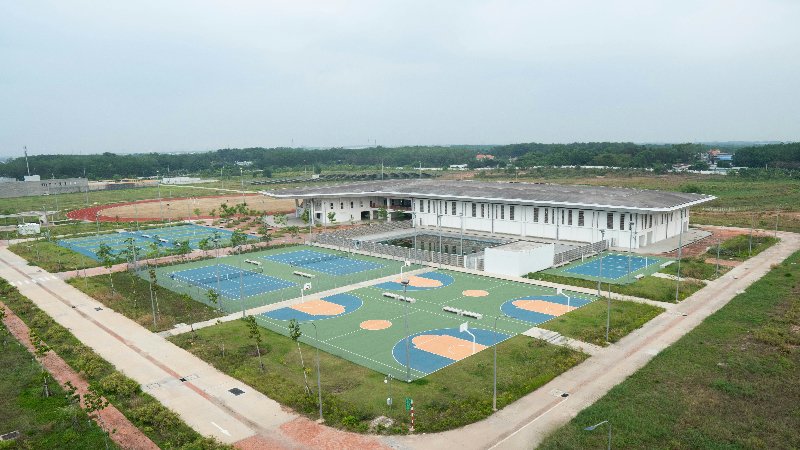Key Takeaways
- Innovative materials and modern technology improve sports court durability, safety, and accessibility.
- Year-round maintenance is crucial for maximizing court lifespan and user satisfaction.
- Sustainable and eco-friendly practices are increasingly important in contemporary court design and upkeep.
- Community involvement in the planning and maintenance fosters broader participation and better facilities.
- Data-driven preventive strategies optimize performance, reduce costs, and keep courts game-ready.
Evolving Materials and Court Designs
Cutting-edge materials are redefining the standards for athletic surfaces across all levels of play. The shift toward advanced polymers, rubberized coatings, and composite layers ensures that modern sports court construction produces surfaces with versatility, long-lasting performance, and improved athlete safety.
Customized synthetic turf and acrylic surfaces, engineered to accommodate various sports and withstand intense weather fluctuations, are now a popular choice among many organizations. Engaging experienced sports construction companies in Kansas City is crucial in making informed decisions about surface selection, installation, and long-term maintenance.
These professionals bring proven expertise in selecting solutions that balance playability and cost efficiency. Their guidance helps ensure the best results for schools, parks, and community centers. Recent industry insights show that choosing the right construction materials can greatly impact player comfort and facility maintenance costs.
Selecting surfaces designed for shock absorption and weather resilience is a strategic move that protects players and investments alike.
Year-Round Maintenance Routines
A proactive approach to maintenance significantly enhances the long-term performance of any sports court construction project. Regular cleaning, debris removal, and routine inspections prevent common issues from developing into costly repairs. Facility managers recommend weekly sweeping, clearing drains to avoid standing water, and repairing small cracks early to extend a court’s lifespan.
Cocourt’s small interventions—such as repainting faded lines and checking surface integrity—help delay major repairs. These simple steps keep courts safe and ready for play all year.
Routine Inspection Checklist
- Sweep surfaces weekly to prevent abrasive buildup
- Inspect and clear drainage systems seasonally
- Monitor for cracks, standing water, or heaving
- Schedule annual professional assessments for safety and surface condition
- Apply fresh paint and adjust lines as needed based on usage
Optimizing Courts for Community Usage
Maximizing court utilization means embracing a multi-sport mindset. Communities increasingly request custom line markings and surface adjustments for basketball, pickleball, tennis, and futsal on the same footprint. This adaptation increases participation opportunities, making better use of available real estate and boosting return on investment.
Gathering feedback from residents and frequent users during the design and update process ensures the court meets real-world demands. Additionally, this input encourages greater community engagement and leads to higher satisfaction. Furthermore, multi-use facilities qualify for a broader range of programming and event hosting, which ultimately enhances their overall value.
Integrating Safety and Accessibility Standards
Safety and accessibility remain essential elements in modern sports court construction. Implementing slip-resistant surfaces, meeting ADA requirements, and using bright, even lighting ensures players of all ages and abilities can enjoy the facilities safely.
Following guidance from organizations such as the National Federation of State High School Associations ensures that facilities meet or exceed national safety standards. Regular audits help identify risks and promptly remedy issues such as worn edges, loose surfaces, or faded boundaries before they lead to injury.
Pursuing Eco-Friendly Solutions
Sustainability continues to influence the future of sports court construction. Court builders can reduce a facility’s carbon footprint by using low-VOC paints, recycled sub-base materials, and permeable paving options that improve stormwater management.
Thoughtful landscaping with native plants reduces the need for irrigation, while integrated subsurface drainage reduces runoff and pollution risks. Not only do these choices support community environmental objectives, but they also help manage operating expenses over a court’s lifespan. Ecocourts increasingly attract funding and grant opportunities from municipalities and green initiatives.
Harnessing Technology for Longevity
Advanced technology equips facility managers with real-time insights into surface performance and emerging issues. Moisture meters, infrared scanners, and digital shock testers reveal hidden problems—like subsurface moisture or material fatigue—before they become hazards.
App-enabled sensors track usage patterns and surface wear, helping facilities plan maintenance when it will be most effective and least disruptive. These innovations shift court management from a reactive to a predictive model, reducing surprises and safeguarding user experience.
Preventive Repairs and Performance Tracking
The most reliable way to ensure a safe, high-performing court is through diligent preventive repairs and systematic tracking of performance metrics. Logging court inspections, tracking when lines or surfaces were last refreshed, and noting emerging issues enable managers to budget for minor repairs long before structural degradation.
This data-driven approach means cracks are filled and hazards are addressed promptly, enabling seamless play and minimizing downtime.
Future Trends in Sports Court Care
Future developments point to modular courts constructed from recycled, high-durability materials that can be replaced or reconfigured as community needs evolve. Integrating remote booking systems, bright lighting, and live usage monitoring will make sports facilities more accessible and user-friendly.
Trends also show that community partnership models are becoming more popular. In these models, municipalities and user groups share maintenance duties and scheduling to encourage local pride and stewardship of public play areas.
Conclusion
Sports court construction and maintenance have entered a dynamic era defined by innovation, community engagement, and a commitment to sustainability.
By leveraging specialized expertise, up-to-date routines, and emerging technology, facilities can create safe, accessible, and versatile spaces that meet the needs of today’s athletes and communities. These modern practices also help facilities remain at the center of active, connected neighborhoods.
See Also: Success Unlocked: Effective Inspection and Test Plans
